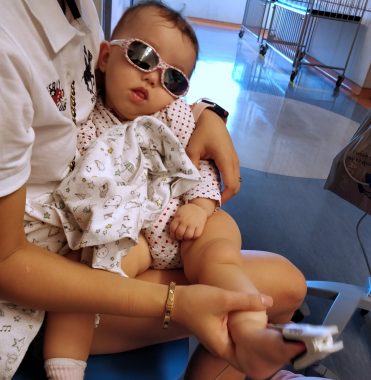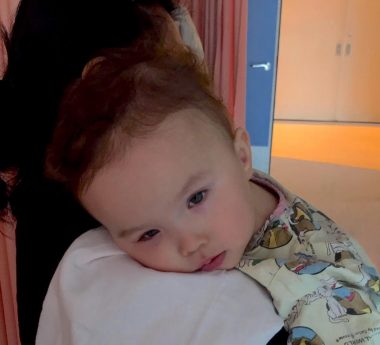The Road to Enrolling in a Clinical Trial
Written by |

The chat message came late in the evening just a couple of weeks before Christmas 2018. My wife, Judy, and I lay in bed staring at our phones, trying to figure out how we could help our daughter, Rylae-Ann. We didn’t even know what she had at the time and had gone through several misdiagnoses over the last six months.
Rylae-Ann was sleeping between us, as usual, so I was a bit annoyed at first when the chime filled our silent room. Our daughter often woke at the slightest sound or movement. Thankfully, she remained sleeping as Judy read the message. With the speed of a tornado, she twisted to face me and said, “Otto knows what she has!”
Judy’s older brother, Otto, randomly found a Facebook post that told the tale of a Taiwanese mother whose child had symptoms similar to Rylae-Ann’s. The video embedded in the linked article explained that although this was an extremely rare disease, the highest incidence was among people of Taiwanese descent.
This revelation was a huge break in our medical mystery. Immediately, I began scouring the internet for information about this disease known as aromatic l-amino acid decarboxylase (AADC) deficiency.

Dad, Mom, and Rylae-Ann travel from Singapore to Taiwan in December 2018 to meet the clinical trial team for the first time. (Photo by Richard E. Poulin III)
Clinical trial
At the time, there weren’t many resources available about AADC deficiency. But late that same night, I found a few research papers that caught my attention because they shared the results of clinical trials. I tried my best to understand the medical jargon, but the late evening wasn’t helping. I was able to gather that an experimental gene therapy could be an option for improving our daughter’s life.
Based on the research papers, two clinical trials had been completed, both in Taiwan. I searched for more information and found the U.S. National Library of Medicine’s Clinical Trials website. I had never visited this site before, but it was easy to use. Entering general search terms like “AADC” will compile a list of related clinical trials. You can filter the results by status, eligibility, location, and more. I was determined to read about them all, so I kept the parameters general and went one by one.
I found an AADC trial on the website, but strangely it listed the older Phase 1 as open and the more recent Phase 2 as closed. These must have been the clinical trial results I had read about in the research papers. I assumed both phases were closed, but I prayed for a mistake in our favor.

Mom holds Rylae-Ann as they register at the hospital to meet the clinical trial team for the first time in 2018. (Photo by Richard E. Poulin III)
Information at your fingertips, but not live
Later I learned that this database might not reflect live information. At the time, it didn’t matter if there were openings. I wanted to talk to the doctors involved. The clinical trial details include contact information and the locations of the trials.
Even though it is an American website, it displays clinical trials happening around the world. Accessing this part of the site lets you connect with the people responsible for enrolling patients.
In addition to not sharing live updates, the website may not have all of the information about the trials. After speaking with the team running the clinical trial that interested us, we learned that both phases were completed and no longer enrolling. We felt dismayed, but the team quickly added that Phase 3 was open.
I discovered that there are usually three phases to a clinical trial. Some clinical trials may start with a Phase 0 or have an additional Phase 4. Contact the group overseeing the trial, regardless of what’s displayed on the website. They will be able to give you the most up-to-date information, including future news.

The view from National Taiwan University Hospital during our 2018 trip to meet with the clinical trial team. (Photo by Richard E. Poulin III)
Make contact
The contact information listed names, emails, and telephone numbers. I wanted to pick up the phone right then and there. Although email seemed like a more polite way of connecting with the research group, we decided to call directly the next morning.
We didn’t speak with a doctor on the phone, but we were able to schedule an appointment for the day after Christmas. On Christmas Eve, we flew from our home in Singapore to meet with the team in Taiwan.
For us, our backs were against the wall. We could either get our daughter enrolled in the clinical trial or face the possibility that she might die soon. Much still needs to be learned about the patients in our small community. Yet the fact remains that life expectancy is incredibly short due to the life-threatening symptoms related to AADC deficiency.

Mom watches over Rylae-Ann during her admission to pediatric intensive care unit for aspiration in 2018. (Photo by Richard E. Poulin III)
Time is not on our side
The hardest part of this journey was the time it took to obtain a proper diagnosis and the time we spent waiting to find out if we could enroll in the clinical trial. Even after enrolling, we had to wait nearly a year before treatment would begin. Every second felt like a wasted moment — another day our daughter had to suffer the side effects.
Although you may have to wait, do not be idle. Continue to make sure your child remains healthy so they are eligible to enter the clinical trial. Complications can unfortunately cause patients to be denied, as they will affect the results of the study.
During these waiting periods, do your best to provide therapy. Using play-based therapy and swim therapy, you and your child can make memories while making progress. The progress may be imperceptible. The improvement may only be internal. Use the time to make even the slightest gain, because every little bit counts.

With a support network to care for Rylae-Ann, we were able to enroll in a clinical trial in another country. (Photo by Richard E. Poulin III)
Searching for answers
Searching for answers may be a long and confusing process. Reach out to those in your rare disease community for support. Also, use the resources online to search for available clinical trials. In addition to the U.S. Clinical Trials website, the National Institutes of Health has another database. There are bound to be other portals, so continue searching and researching.
Do not be discouraged by the information you find, as some information may not be updated or listed. Be proactive and talk face to face with the research team. After finding eligible clinical trials, discuss the details, risks, and potential benefits with the team.
Finally, do not be afraid to travel to another country for treatment. Visiting Taiwan was easier for us than most since my wife speaks Chinese, but we still had to overcome many challenges. Working with your support network, you can find a way to travel to receive treatment.
Note: AADC News is strictly a news and information website about the disease. It does not provide medical advice, diagnosis, or treatment. This content is not intended to be a substitute for professional medical advice, diagnosis, or treatment. Always seek the advice of your physician or other qualified health provider with any questions you may have regarding a medical condition. Never disregard professional medical advice or delay in seeking it because of something you have read on this website. The opinions expressed in this column are not those of AADC News or its parent company, Bionews, and are intended to spark discussion about issues pertaining to aromatic l-amino acid decarboxylase deficiency.






Leave a comment
Fill in the required fields to post. Your email address will not be published.